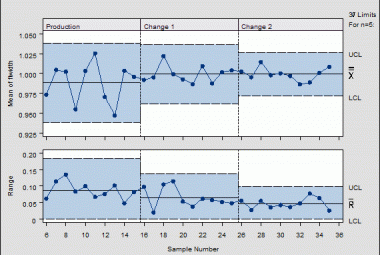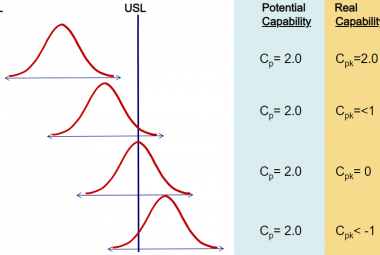The sixth building in the fortress of change is the MONASTERY OF REFLECTION AND FOCUSED GROTWH. Within the name, two important aspects of continuous improvement are captured: focused growth and (self) reflection, or hansei. Focused growth refers to having a clear direction in which you would like your team to improve to (Rother, 2010). This direction starts with having a vision and the cascading of this vision into KPI and behavioral indicates (as described in the Gate of Purpose).
Next to having a clear direction, only when people in the organization take the time to reflect on the past actions, improvements can be implemented (Liker, 2004).
FOCUSED GROWTH is important because people like to see results of their change effort, which the need to stay motivated in using their new behavior (Kotter, 1996). When many small improvements all focus on the same KPI or waste, result will be noticed faster and be more substantial.
When the organization or department does also include a goal to which the specific KPI should be improved to, we can call it the target Condition (Rother, 2010).
Within the lean philosophy, the lead time is the most important KPI because it helps the organization break through the iron triangle by improving quality and delivery, while reducing costs (Krafcik, 1988). Setting a target condition on the lead time of a process is therefore a common strategy, for which the tool Value Stream Mapping can be used.
One level deeper is reducing the wastes (muda) that lead to the longer lead time. Traditionally, processes consists of >90% non value adding activities, hence wastes (Womack & Jones, 1996). The 8 traditional wastes are: defects, overproduction, waiting, non-used talent, transport, inventory, motion and excess processing.
When you implement a suggestion system in your organization, it can help to ask the employee to quantify what waste is addressed by his or her improvement suggestion (or kaizen), which helps in prioritizing the suggestions.
One DEFENITION OF SELF REFLECTION is to honestly judge both your successes and failures in your own actions (Kotter, 1996). Important is that this reflection is used to use this reflection to improve the process and not to blame the person (Liker, 2004).
Reflection is important for everybody. Management should reflect on their actions and whether they are facilitating the improvement culture enough to create a real culture change (Suzaki, 1993). On individual level, reflection is important not only at work, but also at home. Regularly thinking about how you spend your time and if your current way of living brings you happiness (Miedaner, 2000) and whether you are spending your time in things you find important (Covey, 1989). Next to that, self reflection leads to internal motivation which helps people to perform better in their job (Pink, 2010).
REFLECTION means looking back on a certain moment, but can also entail a day or a week. With the help of asking yourself questions, you can evaluate how the situation went, or how your day or week was, what the result of your behavior was in that situation, and how that impacted your own feelings.
The 14 Toyota leadership principles (listed below) and the eight wastes can be used as topics to reflect about. Can you name an example of when you lived one of the lean principles? And how did that influence the situation? Can you name an example of when you showed traditional lean behavior? And where did that get you?
The eight wastes are usually easier to reflect on. How did you spend your time today? What part of the work you did today was value adding and what part was not? How can you prevent yourself from spending time on those non-value adding activities again in the future?
THE 14 TOYOTA PRINCIPLES are (Liker, 2004):
Principle 1: Base your decisions on a Long-Term Philosophy
Principle 2: create Continuous Flow.
Principle 3: use Pull systems to avoid overproduction.
Principle 4: level out the workload
Principle 5: Stop and fix the problem
Principle 6: work with standards
Principle 7: Make problems visual
Principle 8: Use only reliable tested technology
Principle 9: Grow your leaders internally
Principle 10: Develop exceptional people and teams
Principle 11: Respect your Network partners
Principle 12: Go see for yourself
Principle 13: Make decisions slowly by consensus and implement rapidly
Principle 14: Use Hansei (reflection) and Continuous Improvement (Kaizen) to become a Learning Organization
Reflection means thinking about how you acted in the past. First you will need a direction in which you would like to improve. In a lean culture, this could be the 8 wastes or on personal level one of the 14 leadership behaviors. Ask yourself regularly whether you have acted the desired way and how you have spend your time. Use this reflection to how you spend your time by changing your routines.
This can be done by everybody, anywhere, anytime. When all employees in an organization in both production and in management would take the time to reflect on their work and reduce waste from their daily work, real change could take place!
Continue to:
The Lean Toolbox - 8 Steps of Future State VSM design
REFERENCES:
Covey, S. 1989, De zeven eigenschappen voor succes in je leven, Amsterdam: Business Contact. (summary)
Kotter, J.P., 1996, Leading Change, USA: Harvard Business School Press. (summary)
Krafcik, J. F. (1988). Triumph of the Lean Production System. Sloan Management Review, 40-52.
Liker, J.,2004, The Toyota Way – 14 Management Principles From The world’s Greatest Manufacturer, New York: McGraw Hill. (summary)
Miedaner, T., 2000, Coach yourself to Succes – 101 Tips from a Personal Coach for Reaching Your Goals at Work and in Life, Chicago: Contemporary Books. (summary)
Pink, D,H.; 2010; Drive- de verrassende waarheid over wat ons motiveert, Amsterdam: business Contact. (summary)
Rother, M., 2010, Toyota Kata, Managing people for improvement, adaptiveness and superior results, USA: Mc Graw-Hill (summary)
Suzaki, K., 1993; The New Shop Floor Management: Empowering People for Continuous Improvement, New York: Free Press












